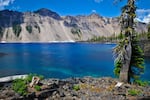You can learn a lot about a lake from space, or at least, you can make some guesses. A survey of satellite data over 26,000 U.S. lakes found that lakes in the Pacific Northwest are staying true to the color blue, while lakes in other regions of the United States are turning more green.
“We’re able to look at these historical and seasonal patterns of greenness,” said U.S. Geological Survey scientist Simon Topp, an author on the paper.
“Lakes are defined by seasonal changes,” Topp and his colleagues wrote in their paper. We can watch the lakes change on the ground: from icy to warm with the seasons, clear to murky with runoff, and from blue to green with algae and plant life. Things like temperature changes, sun and different nutrients can all impact the growth of algae in a lake, and the time of year that lakes turn green.
In the past, studies using satellite data focused on a handful of lakes in one region. But this survey used a newly compiled dataset, called LimnoSat-US. By looking at thousands of lakes instead of just a handful, researchers were able to compare changes in lake color across regions, seasons and 36 years.

Crater Lake in Southern Oregon.
Vince Patton / OPB
The survey found that in much of the U.S., particularly in the Northeast, lakes appear to be murkier and greener for longer parts of the year.
”But in the Pacific Northwest, we see the opposite,” Topp said. Before 2008, many lakes in the Northwest turned green in early spring. But now “we see lakes where there is a consistent seasonal color: blue throughout the summer months.”
It isn’t easy to tell why Northwest lakes have stopped changing color, and have become more year-around blue. But because it’s a trend seen across the entire region, Topp says it’s likely that the same thing is causing the color change in each lake.
If “blue lakes” make you think of Crater Lake, you’d be right on the money. The lake, which sits in the crater of a collapsed volcano, is famed for its sapphire-blue waters. And you can see that blue from space: data from LimnoSat-US shows that Crater Lake has been deep blue for as long as we’ve had satellites pointed at it.
Deep, clear lakes have long been a hallmark of the Pacific Northwest, and deep, clear water absorbs colors. Reds and yellows are absorbed first, while blue is reflected back, and that’s the color we see. The deeper and clearer a lake is, like Crater Lake, the deeper the blue can be.
Crater Lake is blue year-round because it is so clear. It’s what scientists call “ultraoligotrophic.” That means there are not a lot of nutrients in the lake to support things like algae. There are no streams or rivers to bring nutrients and sediments into the lake. Other ultraoligotrophic lakes include Clear Lake and Waldo Lake in Oregon, and Lake Tahoe in California.
But as Topp explained, blue lakes aren’t always clear. Bits of small particles can make a murky lake appear blue by scattering light. This is called the Tyndall effect, and it’s the same reason the sky is blue. (You can recreate this effect at home using a glass of water and a little bit of milk.)
Similarly, clear lakes aren’t always the healthiest: some lakes in the Northeast are more clear because acid rain sapped the nutrients plants and algae need to grow from the water. So why are Oregon’s lakes bucking national trends?
One possibility is glacial runoff. Snowpack and glaciers are shrinking, and melting earlier every year. If fewer nutrients are entering the lakes, they would become more clear and less green.
The lakes could also just be cleaner than they used to be. The earliest information in the LimnoSat-US database is from the 1980s. Regulations around clean water changed dramatically in the 1970s, and have continued to become more strict over the years since.
“We’ve had the Clean Water Act, the Endangered Species Act. Both of which impacted freshwater habitats,” Topp said.
There’s another possibility as well: research on alpine lakes shows that the practice of stocking lakes with non-native trout can bring more nutrients like phosphorus and nitrogen into an ecosystem. Algae needs those nutrients to survive.
Another study found that introduced species like crayfish eat the native insects in lakes, which can lead to more algae. This seems to be happening in Crater Lake, though it’s too soon to say if it’s making the water less clear.

The signal crayfish is considered the perfect invader. It eats a wide variety of plants and animals and has very few natural predators in Crater Lake.
Katie Campbell, KCTS9/EarthFix
Those nutrients can make algae grow and make the water more green. But the U.S. Fish and Wildlife Service stopped stocking many lakes in the 1990s, and the number of lakes that are stocked has continued to decrease ever since.
Or it could be even more perplexing. “It’s almost the opposite of what you might expect to see,” Doug Larson, a retired researcher who studied Cascade lakes and lake clarity during the period Northwest lakes grew more steadily blue, “Usage of these lakes has gone way, way up.”
And the more people use a lake, the more nutrients end up in it. Though it’s also possible that changes in how human waste is handled in these lakes could offset the murkiness, Larson said. Waldo Lake, which Larson studied for decades, now pumps human waste off site.
And that’s a good thing, Larson said. “It really is a remarkable lake.”

